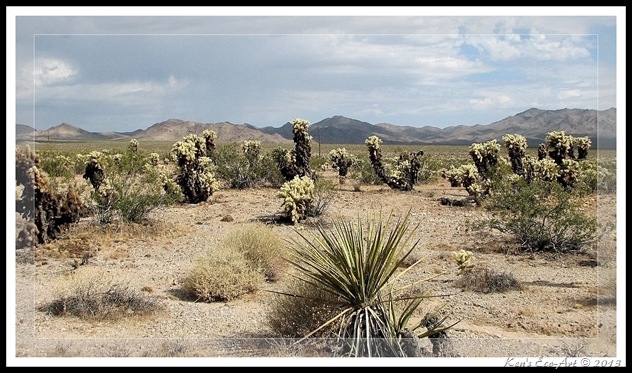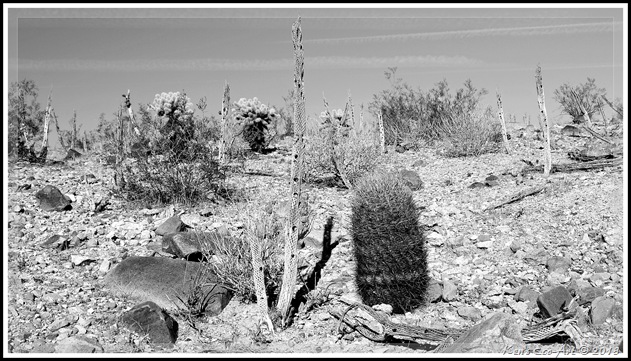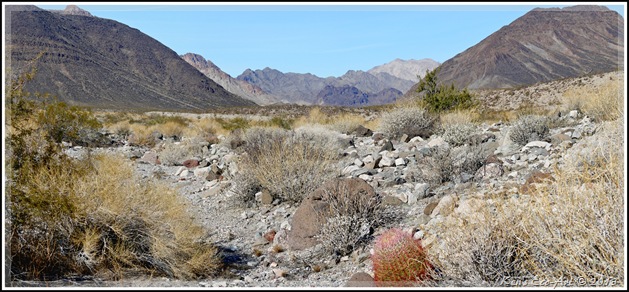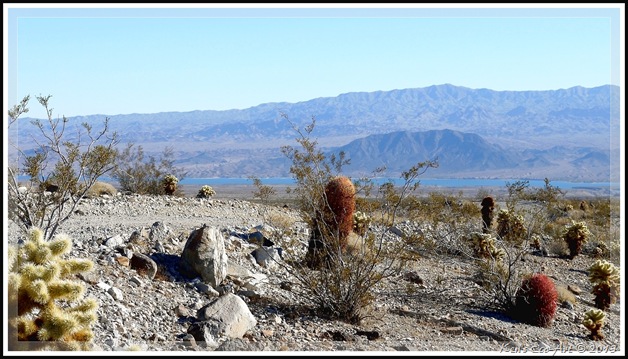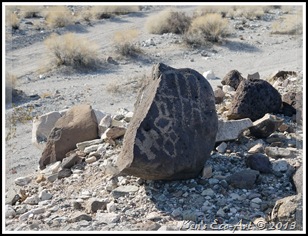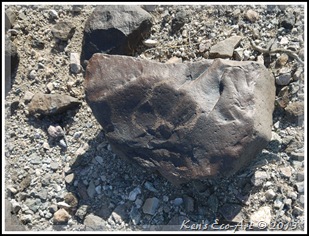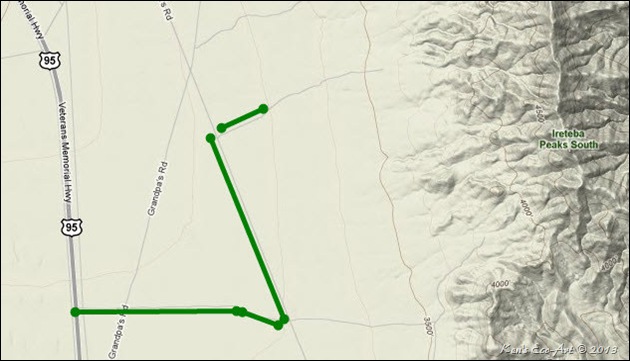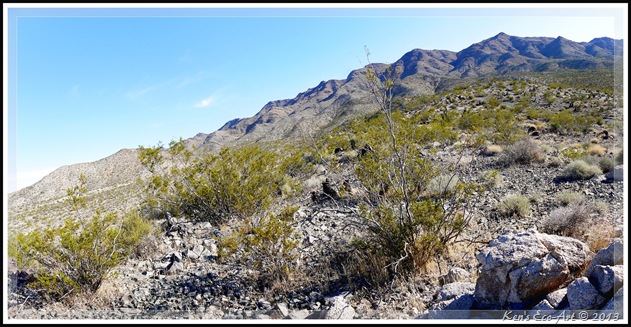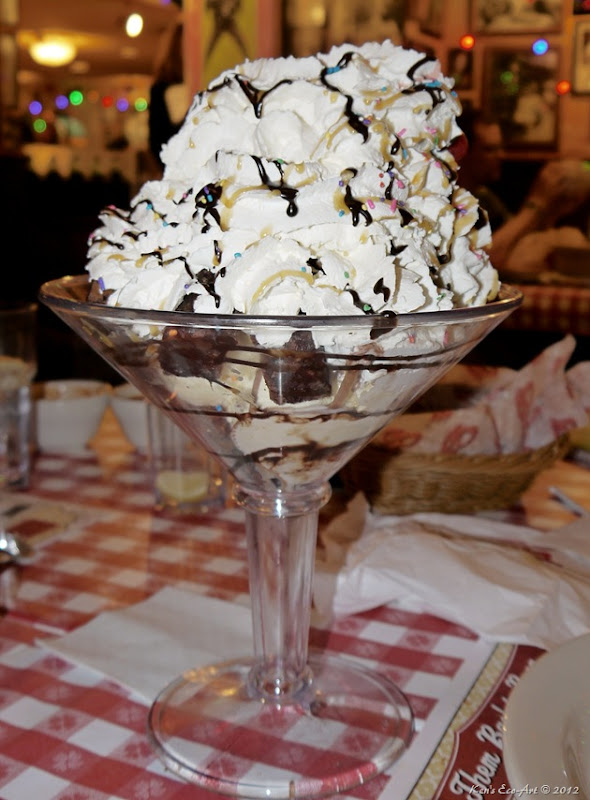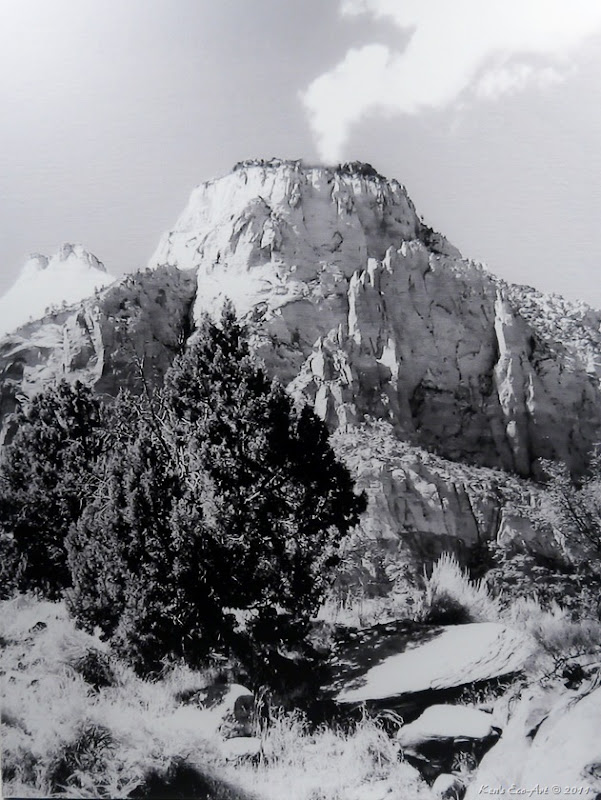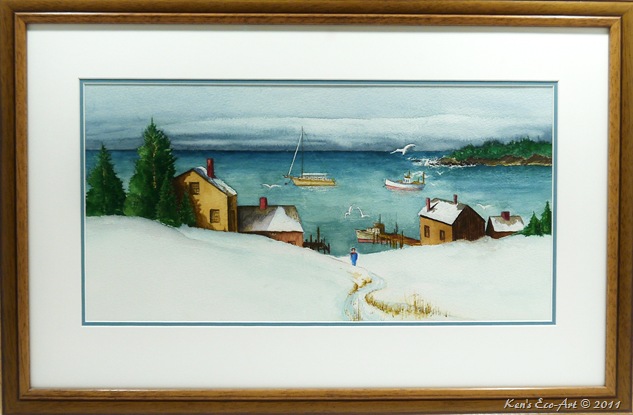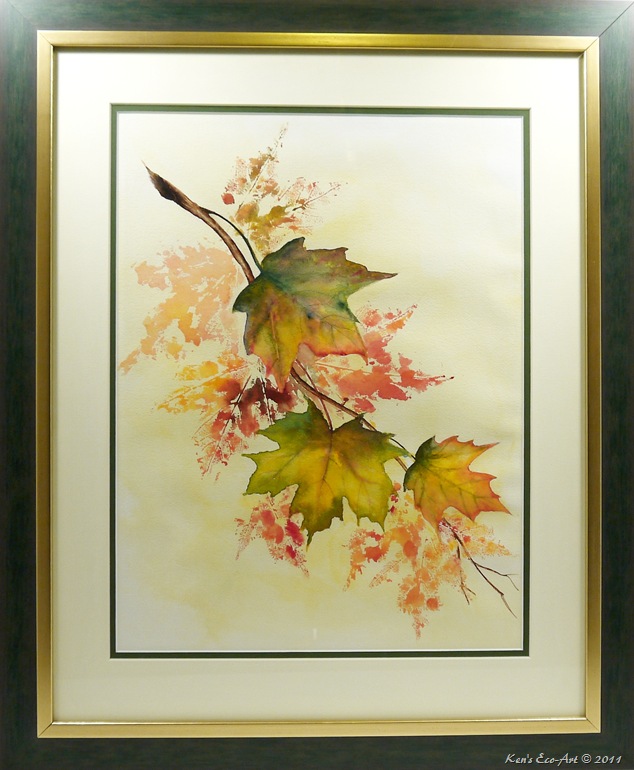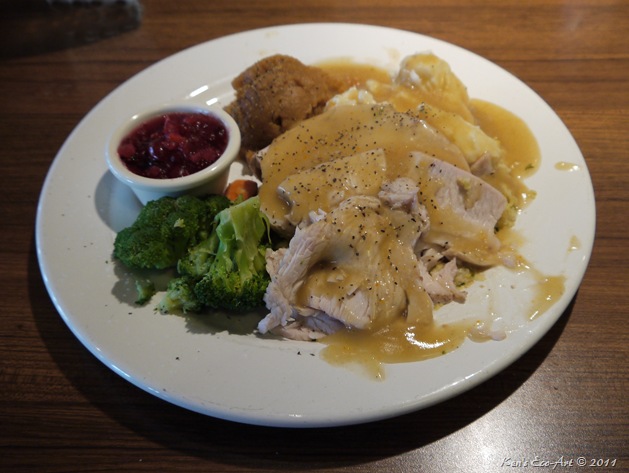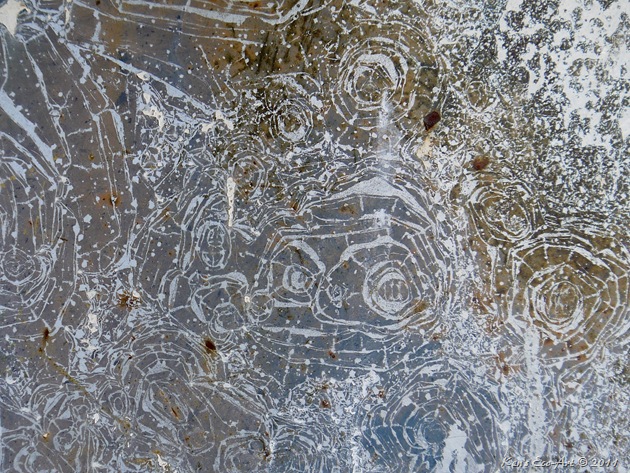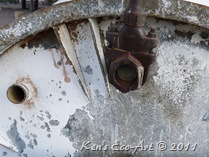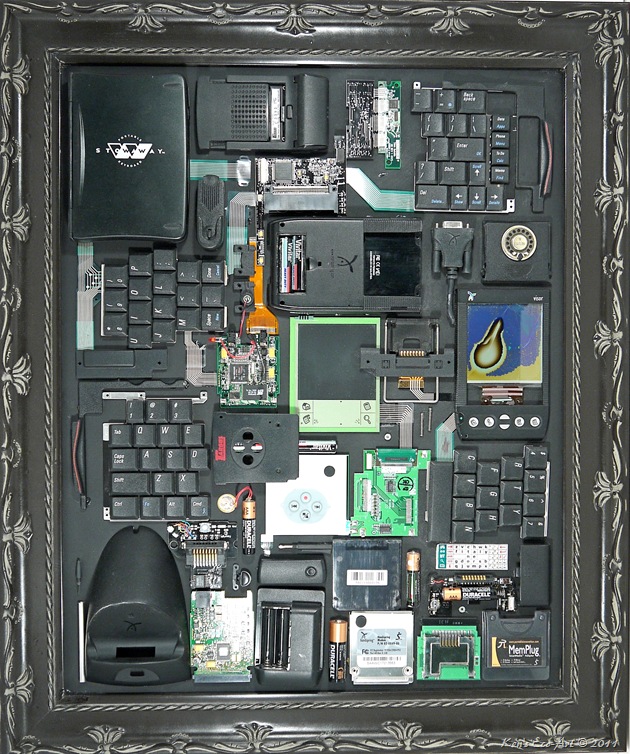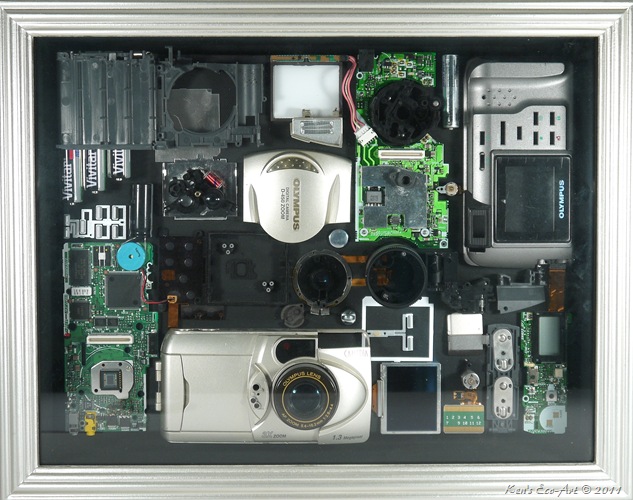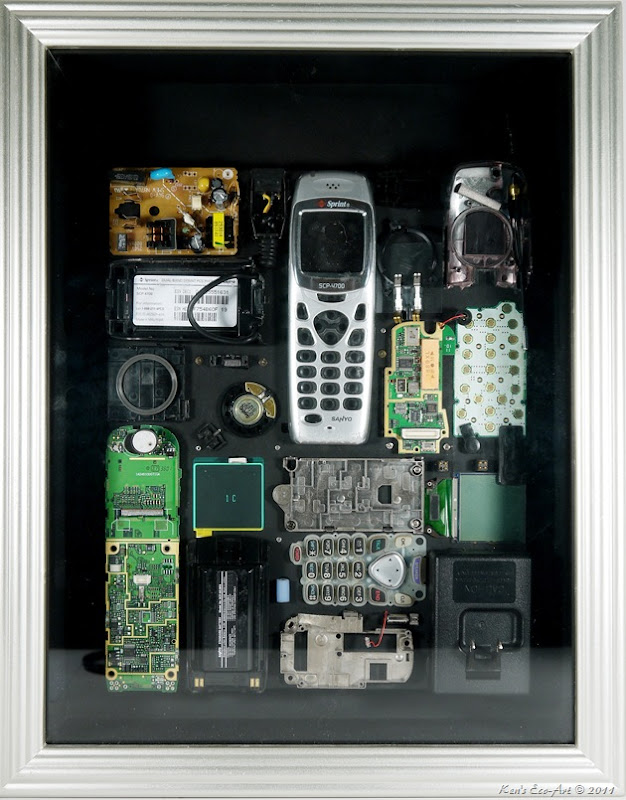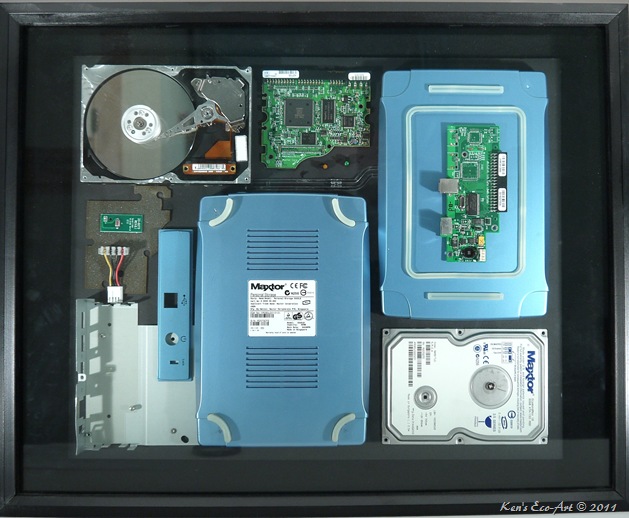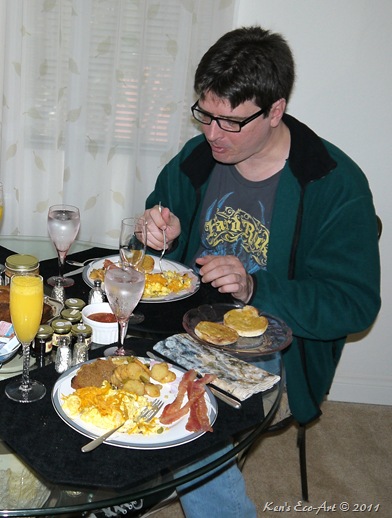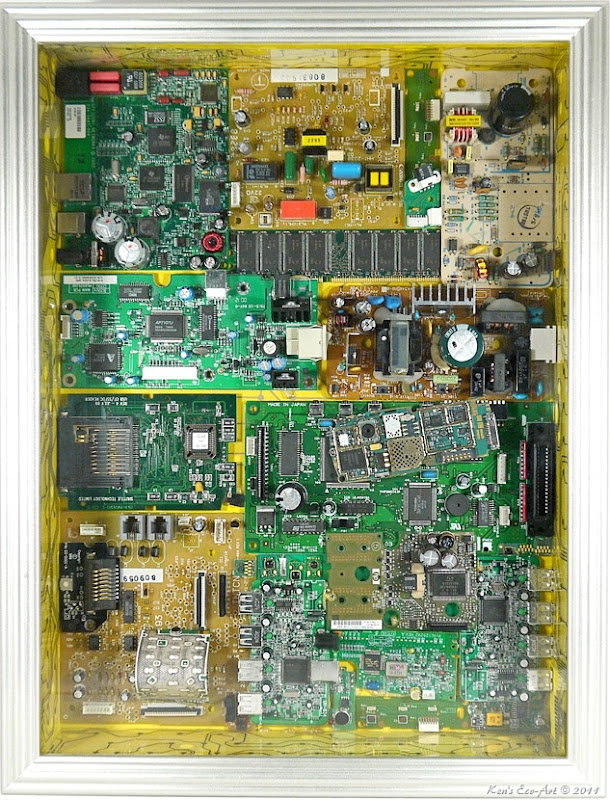{Click on an image to enlarge, then use the back button to return to this page} This page last updated on 04/20/2019 | ||||||
| ||||||
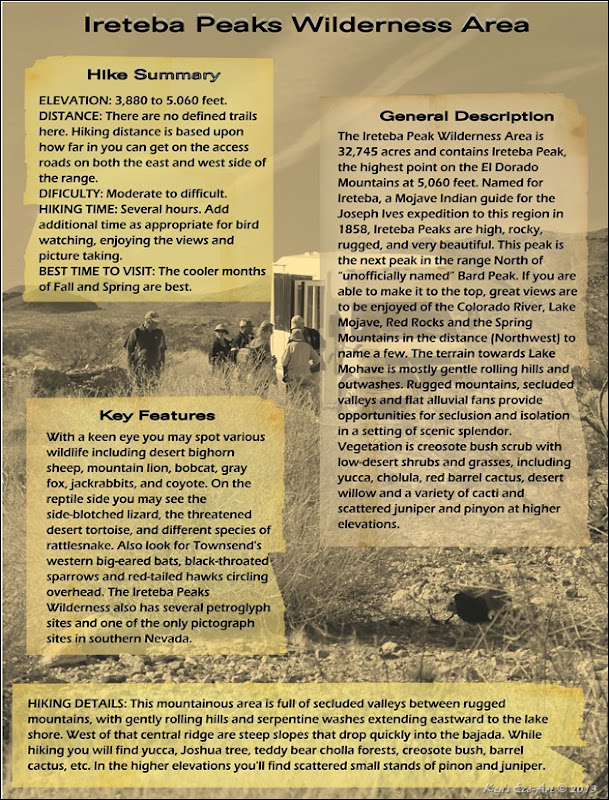 | ||||||
 | ||||||
| ||||||
| 04/16/2019 Trip Notes: This time Jim Herring, Bob Croke, Ron Ziance and Howard Saxon took our jeeps out to the area of the Rockefeller Mine near the southern end of the Ireteba Peaks Wilderness Area (Fig. 02). Mostly we just visited some of the areas' abandoned mines and enjoyed the views of the mountains and vistas. Click here for pictures and a description of this trip ... Ireteba Peaks Wilderness Area - 04/16/2019 Trip Notes. 05/07/2013 Trip Notes: A few days later than my previous visit, I made yet another attempt with my friend Harvey Smith to visit the Ireteba Peaks Wilderness Area. Even though we got further into this area than on any of our previous three visits, and got to explore more than a half dozen abandoned mines, we still only just barely reached the southern edge of the Ireteba Peaks Wilderness Area boundary. Click the following link to view notes and pictures of today’s visit ... 05/07/2013 Update - Ireteba Peaks Wilderness Area. 05/02/2013 Trip Notes: Even though this is the third time the rock-hounds have visited this location, we have yet to even reach the southern boundaries of the Ireteba Peaks Wilderness Area. Refer to the map in (Fig. 02). Due to the travel limitations of our van, all of our hiking has been inside the boundaries of the LMRA. Again we parked at the intersection of Indigo Road (#37), about 2.5 miles in from Cottonwood Cove Road (NV-164). Refer to (Fig. 02). As seen in (Fig. 01), this entire lower desert bajada area is covered with hundreds of barrel cactus and thousands of “ground creeping” Cholla cacti. Compared to a Saguaro cactus which may live to 150-200 years, the lifespan of the Cholla cacti tend to be less than 20 years, which may explain why we saw so many dead trunks (Fig. 03) scattered throughout the area. Though hikers headed off in various directions, some down Indigo Road, some down Rockefeller Road, and some into the wash that paralleled the road; all returned far short of the allotted time due to the strong winds which made the hiking rather un-enjoyable. | ||||||
| ||||||
| 11/17/2011 Trip Notes: On this, our second attempt to reach the Ireteba Peaks Wilderness Area by approaching from the Eastern side, again our attempt resulted in failure. Approaching from Cottonwood Cove Road, we entered the light-green shaded area of the Lake Mead National Recreation Area. As you can see from the notation in (Fig. 02) we parked at the intersection of Indigo Road, still miles from the base of the Ireteba range. Having hiked two miles down Rockefeller Road, I captured the picture in (Fig. 04) looking northwest. The two peaks in the first (reddish) ridge-line behind the dark volcanic mound iin the foreground on the left are called Copper Mountain East. The next, (purplish) ridge-line that stretches across the center of the pictures is the Dupont Mountain range. The high distant (grayish) range beyond that, just right of center, is the southern end of the Ireteba Peaks range. Click on the picture to enlarge. From the same spot, turning and looking eastward (Fig. 05) you get a glimpse of the Lake Mojave (e.g. the Colorado River). On the way out we walked along the upper edge of a wash that paralleled the road and found two rocks (Figs. 06 & 07) containing pictographs. | ||||||
| ||||||
| ||||||
| ||||||
| ||||||
| 10/27/2011Trip Notes: An Internet page I found noted, “a 4WD is not needed to get here, but a high clearance vehicle is.” As can be expected, this statement depends upon the weather over the previous days. On today’s trip the road was so washed out from last week’s rains, that we were only able to travel less than three-quarters of the way, leaving us about a mile and a half short of the ‘guzzler’ at the end of the road, and far short of the base of the range and any chance of climbing up Ireteba Peaks. From what you can see from the map in (Fig. 08) above, Ireteba Peaks is rather long ‘range’ that runs north and south. Even after hiking nearly a mile towards the Ireteba range, we were still quite some distance (Fig. 09) from actually being able to climb up into the mountains. Needless to say picture taking opportunities were rather sparse. We did find dozens of very large holes, apparently the homes of the desert tortoise that are known to frequent this area. These underground burrows allow these tortoise to escape the heat and live through ground temperatures that may exceed 140 degrees Fahrenheit in the summer months and freezing temperatures during winter. Because this is the time of year (November through February or March) when they become dormant and the fact that they spend nearly 95% of their life underground, we did not find any roaming about on today's hike. Maybe better luck next time. After we left this area we traveled to Keyhole Canyon, where we had much better luck with pictures and rock hounding. | ||||||
|
Thursday
Ireteba Peaks Wilderness Area - Summary Page
Wednesday
The Colossal Brownie Sundae!
Thursday
Category Description
Tilt-Shift Photography: This category was created to display photos that have been converted to a Tilt-shift picture. "Tilt-shift photography" refers to the term is used when the shallow depth of field is simulated with digital post-processing, as will be the case for the photos shown here.
Category Description
Series Background: So far there are seven pieces in my Eco-Art series titled, "Recycled Wall Art". I originally got the idea after a failed attempt at trying to 'fix' one of my old digital cameras after its telephoto lens mechanism stopped working. However, after seeing the camera's intricate insides, I thought, why not take it completely apart and use its pieces to create something to remember it by instead of just throwing it away. Thus, it began ...
Wednesday
Index for Category - Textures & Patterns
This page last updated on 12/29/2017
Click on a Title to View
|
Index for Category – Recycled Wall Art
|
Index for Category – Tilt-shift Photos
This page last updated on 02/16/2018
Tuesday
Lava Man – Guardian of the Canyon
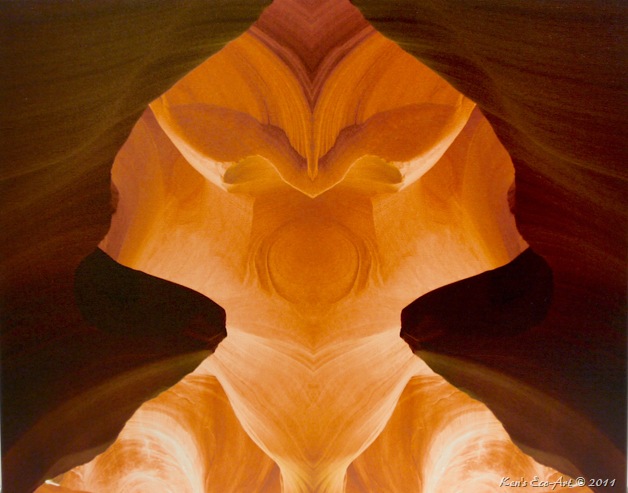 |
| Lava Man – Guardian of the Canyon by Kenneth Clarke: I shot the original image for this picture canvas while on a hiking tour through the lower Antelope (slot) Canyon, located just outside of Page, Arizona. To buy a one-of-a-kind original gallery wrap of this picture, go to Ken's Eco-Art Gallery. This website provides purchase information for various pictures and art pieces I've created over the past few years. |
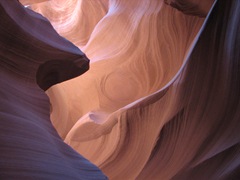 The ’alien-like’ image above was created from the photo on the right. When I began playing around with the image, I think it was the section in the rock face that looked somewhat like an ‘eye’ that first caught my attention. First I flipped it. Then I cut it in half, duplicated it and pasted the two halves together. Finally I enhanced the color and saturation until I arrived at the fiery ‘molten-lava-like’ image above. The ’alien-like’ image above was created from the photo on the right. When I began playing around with the image, I think it was the section in the rock face that looked somewhat like an ‘eye’ that first caught my attention. First I flipped it. Then I cut it in half, duplicated it and pasted the two halves together. Finally I enhanced the color and saturation until I arrived at the fiery ‘molten-lava-like’ image above. |
Reflections
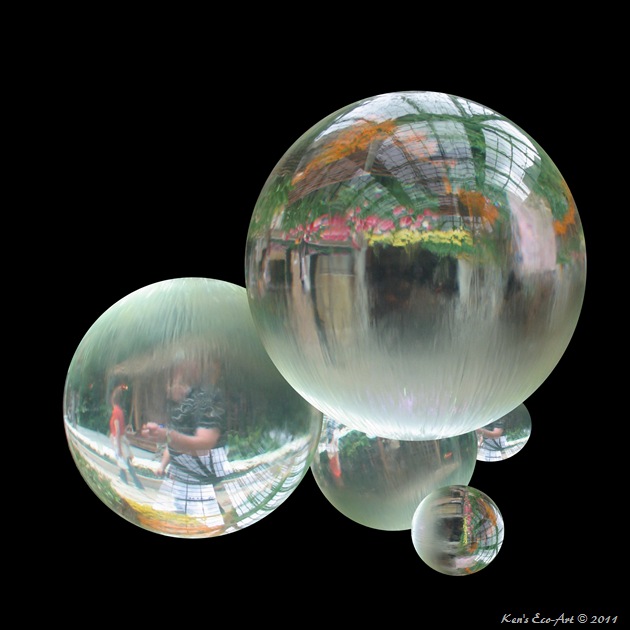 |
| Reflections by Kenneth Clarke: This abstract was created from a series of photos taken at the Spring 2009 exhibit entitled, “Gardens From Around the World”, at the Conservatory & Botanical Gardens inside the Bellagio Casino in Las Vegas.
To buy a one-of-a-kind original gallery wrap of this picture, go to Ken's Eco-Art Gallery. This website provides purchase information for various pictures and art pieces I've created over the past few years. |
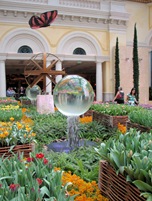 How it was Created: There were several fascinating displays that had water flowing out of the top of hollow glass globes as shown in the picture on the right. I took several pictures from varying positions in order to get different reflections on the water flowing over the globes. After using Paint Shop Pro to clean up and color enhance some of the shots, I then used Scrapbook Factory Deluxe to crop just the globe portion of the photo onto a black background. Adjusted their size and arranged for a look of depth. After grouping and enlarging I then exported the file as a .JPG. How it was Created: There were several fascinating displays that had water flowing out of the top of hollow glass globes as shown in the picture on the right. I took several pictures from varying positions in order to get different reflections on the water flowing over the globes. After using Paint Shop Pro to clean up and color enhance some of the shots, I then used Scrapbook Factory Deluxe to crop just the globe portion of the photo onto a black background. Adjusted their size and arranged for a look of depth. After grouping and enlarging I then exported the file as a .JPG. |
Eminent Danger - Zion B&W Series #001
| ||
| Zion B&W Series #001 by Kenneth Clarke: This view of the Beehives was taken from one of the switchbacks along UT-Route 9 that leads up to the tunnel near the top of the Zion-Mount Carmel Highway inside Zion National Park. To buy a one-of-a-kind original gallery wrap of this picture, go to Ken's Eco-Art Gallery. This website provides purchase information for various pictures and art pieces I've created over the past few years. | ||
Ansel Adams, best known for his black-and-white photographs of the Yosemite National Park, is one of my all-time favorite photographers. Following in his tradition, I sometimes find myself trying to view what a shot will look like in B&W, even before taking the picture. In many photographs, color distracts from the overall effect of the picture; whereas a black and white photo allows one to focus solely on key forms and details that are present within the image. Changing it to black and white tones down the distractions and makes the flowing shapes much more noticeable. | ||
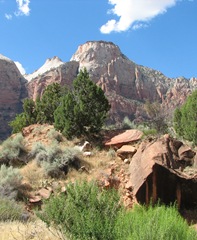 As you can tell by viewing the original photo on the right, I first cropped the image to help better concentrate one’s focus onto the two mountain peaks. When I captured this shot, I immediately noticed that the cloud formation just above the main peak resembled what looked like an Indian smoke signal rising from the top of the mountain. To further enhance this effect I cheated just a little by making the cloud more ‘wispy’ and then bringing it down to meet with the top edge of the peak. Finally, converting it to a black and white and enhancing the contrast not only brought out the detail of the rocky cliffs, but also made the cloud look more like smoke. As you can tell by viewing the original photo on the right, I first cropped the image to help better concentrate one’s focus onto the two mountain peaks. When I captured this shot, I immediately noticed that the cloud formation just above the main peak resembled what looked like an Indian smoke signal rising from the top of the mountain. To further enhance this effect I cheated just a little by making the cloud more ‘wispy’ and then bringing it down to meet with the top edge of the peak. Finally, converting it to a black and white and enhancing the contrast not only brought out the detail of the rocky cliffs, but also made the cloud look more like smoke. | ||
Smoke Signals: Many North American Indians communicated via the smoke signal; a kind of Indian telegraphy. Reputedly the location of the smoke along the incline conveyed a meaning. If it came from half way up the hill, this would signify all was well, but from the top of the hill it would signify danger. |
Wagon Wheels - Need A Spare?
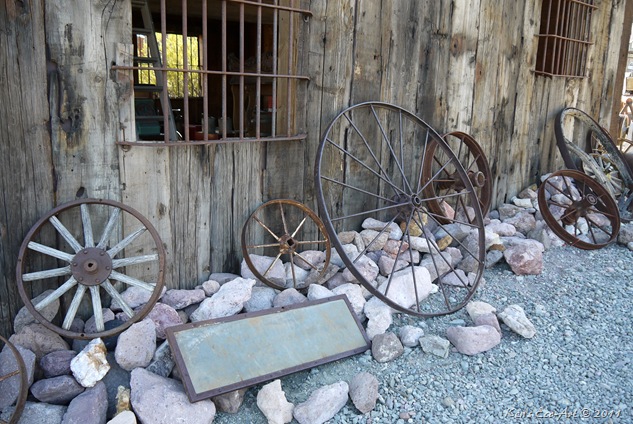 |
| Vintage antique wagon wheels come in many styles, sizes and shapes. From old western wagon wheels made of wood to vintage iron wagon/tractor wheels. All of these pictures were taken at the Techatticup Mining Camp located in Eldorado Canyon, Nevada. Click here to view my polyptych of wagon wheels ... They Just Keep Rolling Along. |
 | 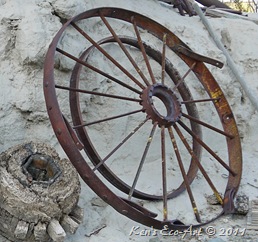 |  |
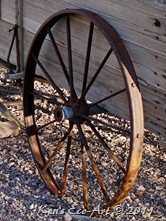 | 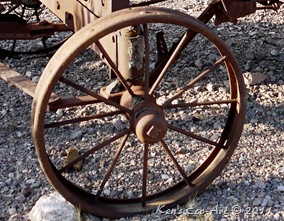 | 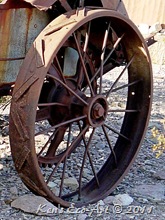 |
| Wheel Making: A person who builds or repairs wheels is called a wheelwright (or wainwright). The word is the combination of "wheel" and the archaic word "wright", which comes from the Old English word "wryhta", meaning a worker or maker. This occupational name eventually became wheelwright. Historically, these tradesmen made wheels for carts and wagons by first constructing the hub, the spokes and the rim/fellows segments, and assembling them all into a unit working from the center of the wheel outwards. Most wheels were made from wood, but other materials such as bone and horn have also been used. Around the middle of the 19th century, iron strakes were replaced by a solid iron tyre custom made by a blacksmith, who first measured each wheel to ensure proper fit. Strakes were lengths of iron that were nailed to the outside of wheels to hold wooden wheels together. Strakes were replaced around the mid-19th century by more dependable iron tires that were fastened to the wooden wheel by both the tight fit of the tire/band as well as tire-bolts. Tire-bolts were less likely than tyre-nails to break off because they were flush with the wheel's outer surface. Here is a great site for learning all about wagon wheels and their associated terminology ... http://www.customwagons.com/wagonwheels1.htm. |
A Taste of Maine
| ||
| Watercolor by Kenneth Clarke: This original watercolor was painted in the winter of ‘97 while I was living in Westbrook, Maine, was only my second painting. I got the inspiration from a scene I found in a magazine which I then embellished by adding the boats in the harbor and the storm in the distance. To buy a one-of-a-kind original gallery wrap of this picture, go to Ken's Eco-Art Gallery. This website provides purchase information for various pictures and art pieces I've created over the past few years. | ||
Autumn Leaves
| ||
| Watercolor by Kenneth Clarke: This original watercolor was painted in the fall of ‘96 while I was living in Westbrook, Maine, and was my very first painting. It was my first year of retirement and with winter approaching, I decided that I needed something to do in my spare time. To buy a one-of-a-kind original gallery wrap of this picture, go to Ken's Eco-Art Gallery. This website provides purchase information for various pictures and art pieces I've created over the past few years. | ||
Turkey Day - 2011
What Is It?
Wall Collage #001
| ||
| Series: Recycled Wall Art - Collage #001 - To buy this one-of-a-kind piece of wall art, go to Ken's Eco-Art Gallery. This website provides purchase information for various pictures and art pieces I've created over the past few years. | ||
| Series Background: This was actually my first creation for my Eco-Art series titled, "Recycled Wall Art". To learn more about this series, read the entry, Category Description. Collage Background: I build this one to remind me of the hundreds of dollars that I had invested over time, not only in the original purchase, but also in a variety of plug-ins and attachments. This collage is comprised of the screen, circuit boards, keyboard button controls, batteries and other internal components from my Handspring Visor. It also includes the desktop charger, various plugin attachments such as MemPlug and the attachable keyboard from Stowaway. I took a plain white, stretched canvas on a wood frame and spray painted it black. Leaving a half-inch boarder all the way around for framing, I organized the pieces to fit within the allotted boundary and began gluing them down. Finally, I had it framed. |
Wall Collage #002
| ||
| Series: Recycled Wall Art - Collage #002 - To buy this one-of-a-kind piece of wall art, go to Ken's Eco-Art Gallery. This website provides purchase information for various pictures and art pieces I've created over the past few years. | ||
| Series Background: Even though this camera was the inspiration for these projects, it was the second creation for my Eco-Art series titled, "Recycled Wall Art". To learn more about this series, read the entry, Category Description. | ||
| Collage Background: As I was building this one I began to realize how often we have a tendency to replace things such as cameras, cell phones, computers, printers, etc., and vowed to never throw anything like that away again. I only wish that I still had some of the hundreds of ‘electronic’ items that I have thrown away over the years. For some unknown reason the lens failed to retract all the way from its zoomed out position. After a failed attempt at taking it apart and trying to lubricate and fix it, I had the idea of using the parts for a collage. Probably the most painstaking part of creating these collages is disassembling the items without 'breaking' some of the more delicate pieces. Once I had a table full of pieces, I began the arrangement process on a piece of black foam-board. Once completed, I encased it inside a box frame. |
Wall Collage #003
| ||
| Series: Recycled Wall Art - Collage #003 - To buy this one-of-a-kind piece of wall art, go to Ken's Eco-Art Gallery. This website provides purchase information for various pictures and art pieces I've created over the past few years. | ||
| Series Background: This cellphone was the third creation for my Eco-Art series titled, "Recycled Wall Art". To learn more about this series, read the entry, Category Description. | ||
| Collage Background: This phone was kind of a disappointment, only due to the fact that it didn’t have as many pieces inside as I had hoped. This collage was arranged on a piece of black foam-board and then encased inside of a box frame. |
The Hay Wagon
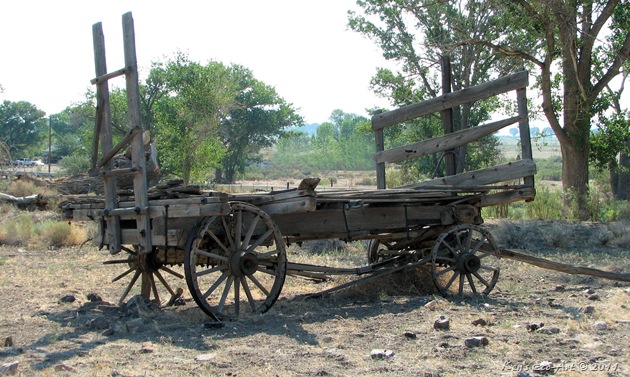 |
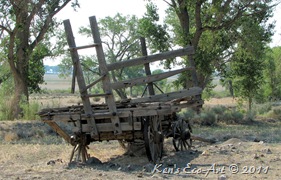 I took this picture of an old hay wagon just east of Wilson Canyon, Nevada back in August of 2009. Who knows how many years ago this wagon saw its last day of use. As you can see from the panorama below, that was taken of a field directly behind where this wagon sat, they are still farming this area, albeit with much newer and more modern equipment. I took this picture of an old hay wagon just east of Wilson Canyon, Nevada back in August of 2009. Who knows how many years ago this wagon saw its last day of use. As you can see from the panorama below, that was taken of a field directly behind where this wagon sat, they are still farming this area, albeit with much newer and more modern equipment. |
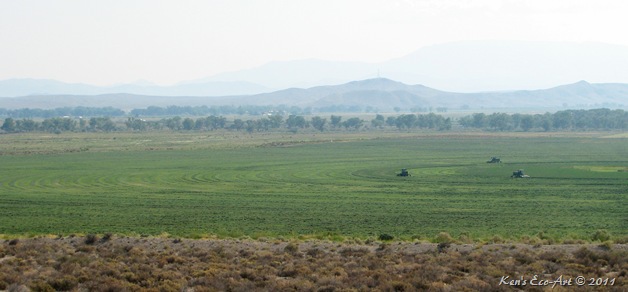 |
Wall Collage #004
| ||
| Series: Recycled Wall Art - Collage #004 - To buy this one-of-a-kind piece of wall art, go to Ken's Eco-Art Gallery. This website provides purchase information for various pictures and art pieces I've created over the past few years. | ||
Series Background: This external hard drive was the fourth creation for my Eco-Art series titled, "Recycled Wall Art". To learn more about this series, read the entry, Category Description. | ||
| Collage Background: Owning these can bring back memories. I can remember that my first purchase of an external drive for my double floppy drive computer was 10MB. Then I bought this 80GB drive. I then bought a 250MB external drive that I still use, even though my computer now had 1TB of internal storage on two 500GB drives. Though I had hoped to end up with more pieces from this item, many of the screws appeared to be ‘cemented’ or glued in place making it too difficult or impossible to take apart any further without damaging the pieces. This collage was arranged on a piece of black foam-board and then encased inside of a box frame. |
Wall Collage #005
| ||
| Series: Recycled Wall Art - Collage #005 - To buy this one-of-a-kind piece of wall art, go to Ken's Eco-Art Gallery. This website provides purchase information for various pictures and art pieces I've created over the past few years. | ||
| Series Background: This camera was the fifth creation for my Eco-Art series titled, "Recycled Wall Art". To learn more about this series, read the entry, Category Description. | ||
| Collage Background: Though black backgrounds seem to work well for these collages, I decided to try something new this time and sprayed the inside of the cardboard for the box frame yellow. I think it made for a good contrasting color against the black, green and bronze colored pieces. This camera was one that was using prior to the purchase of the Olympus in Collage #002. |
They Just Keep Rolling Along
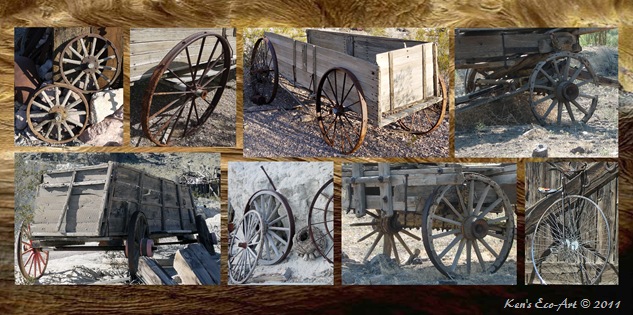 |
| The combination of pictures in this Polyptych, representing old ore wagons, hay wagons, and even a unicycle, were taken at four different times and locations over the past several years. Some were taken at the Techatticup Mining Camp located in Eldorado Canyon, Nevada, some near Wilson Canyon, Nevada, and some at Silverton, Colorado. Click the picture to enlarge. |
Brunch Preparations – Our House
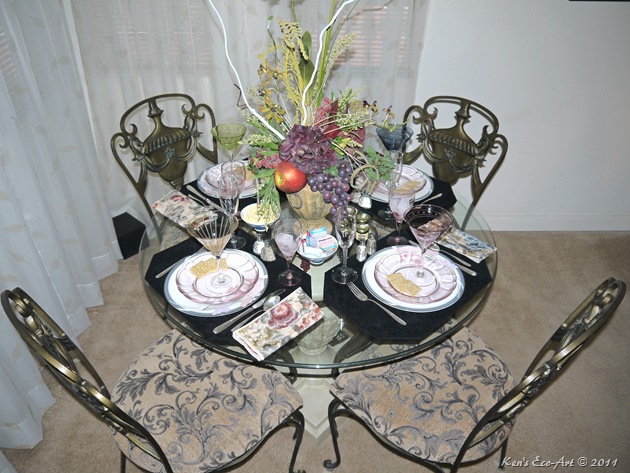 | ||
| ||
Wall Collage #006
| ||
| Series: Recycled Wall Art - Collage #006 - To buy this one-of-a-kind piece of wall art, go to Ken's Eco-Art Gallery. This website provides purchase information for various pictures and art pieces I've created over the past few years. | ||
| Series Background: This was actually my sixth creation for my Eco-Art series titled, "Recycled Wall Art". To learn more about this series, read the entry, Category Description Collage Background: This collage is comprised of circuit boards, keyboard wiring circuitry, and a electronic pieces from variety of electronic ‘gadgets’ including disassembled printers, computers, scanners, cell phones, camera, etc. It is all set in a three-inch deep glass enclosed shadow box. Having sprayed the inside surfaces yellow, I then covered these surfaces with the transparent circuit diagrams that I retrieved from several keyboards. The lines on these kind of represent the roads or streets within the city. I then arranged various tan and green circuit boards to represent the ‘city blocks’, with their attached transistors, plugs, diodes, chips, etc., being representational of ‘buildings’, ‘water towers’, ‘arenas’, ‘warehouses’, etc. One could even construe that each green circuit board represents a ‘campus’ with its ‘buildings’ surrounded by grass and the circuits themselves being the paths and walkways. It is nearly impossible to appreciate the three dimensional effect of this piece in a photograph; it has to be seen to be truly appreciated. | ||
Birth of an Arch - Zion B&W Series #002
| ||
| Zion B&W Series #002 by Kenneth Clarke: This view was taken from one of the switchbacks along UT-Route 9 that leads up to the tunnel near the top of the Zion-Mount Carmel Highway inside Zion National Park. Though at first glance this appears to be some type of cave or arch, it is really neither. It is merely the result of thousands of years of weathering which has caused the softer sandstone to erode and ‘wash away’. To buy a one-of-a-kind original gallery wrap of this picture, go to Ken's Eco-Art Gallery. This website provides purchase information for various pictures and art pieces I've created over the past few years. | ||
Subscribe to:
Posts (Atom)

